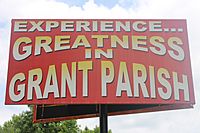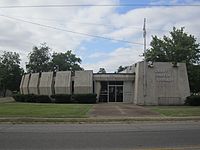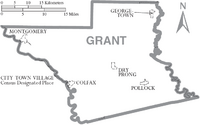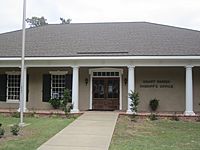Grant Parish, Louisiana facts for kids
Quick facts for kids
Grant Parish, Louisiana
|
|
|---|---|
| Parish of Grant | |
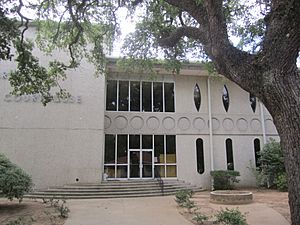
Grant Parish Courthouse in Colfax
|
|

Location within the U.S. state of Louisiana
|
|

Louisiana's location within the U.S.
|
|
| Country | |
| State | |
| Region | Central Louisiana |
| Founded | 1869 |
| Named for | Ulysses S. Grant |
| Parish seat | Colfax |
| Largest town | Montgomery (area) Colfax (population) |
| Area | |
| • Total | 1,720 km2 (665 sq mi) |
| • Land | 1,670 km2 (643 sq mi) |
| • Water | 60 km2 (22 sq mi) |
| • percentage | 9 km2 (3.3 sq mi) |
| Population
(2020)
|
|
| • Total | 22,169 |
| • Density | 12.871/km2 (33.337/sq mi) |
| Time zone | UTC-6 (CST) |
| • Summer (DST) | UTC-5 (CDT) |
| Area code | 318 |
| Congressional district | 5th |
Grant Parish is a parish in the central part of Louisiana, a state in the U.S.. In 2020, about 22,169 people lived here. The main town and parish seat (like a county seat) is Colfax.
Grant Parish was created in 1869, right after the American Civil War. This time was known as the Reconstruction era. It's part of the Alexandria area and the Red River Valley.
From the 1940s to the 1960s, many African Americans moved away from the parish. They left the farming areas to find better chances in other parts of the country. Grant Parish was formed from parts of Winn and Rapides parishes.
The United States Penitentiary, Pollock is also located in Grant Parish.
Contents
History of Grant Parish
Grant Parish was once part of the larger Rapides Parish to the south. Before the American Civil War, a busy spot was "Calhoun's Landing." It was named after Meredith Calhoun, a planter who grew cotton and sugar. He also ran a newspaper in what became Colfax.
How Grant Parish Was Formed
The parish was created in 1869 during the Reconstruction period. This was a time when the government tried to rebuild the South after the Civil War. Grant Parish was named after U.S. President Ulysses S. Grant. The main town, Colfax, was named after his vice president, Schuyler Colfax.
The parish had many cotton farms and pine forests. It was one of several places along the Red River that saw a lot of fighting during Reconstruction. White residents tried to keep control over society.
The Colfax Massacre
In 1872, there was a big argument over who won the governor's election. This led to problems with local officials in Grant Parish. Republican officials took over the courthouse in Colfax. They were protected by freedmen (formerly enslaved people) and state militia members, who were mostly freedmen. They worried that the Democratic Party would take over the parish.
On Easter Sunday in 1873, white groups gathered and marched on the courthouse. This led to a terrible event where many people were killed. Three white people and between 120 and 150 Black people died. About 50 Black prisoners were killed that night. This event was first called the "Colfax Riot," but historians now call it the Colfax Massacre to show how serious it was. The exact number of Black people who died is unknown because some bodies were hidden.
A former Confederate officer named Christopher Columbus Nash led the white group. Many of these white fighters later formed the first group of the White League. This group used violence to scare Black voters. The White League helped white Democrats regain power in Louisiana by 1876. After this, most Black people lost their right to vote until the Civil Rights laws of the 1960s.
Population Changes and Politics
Grant Parish has seen its population change over time. Between 2001 and 2006, it had the fastest growth rate in central Louisiana. This was a 4.3 percent increase.
In terms of politics, Grant Parish usually votes for the Republican Party in national elections. For example, in the 2016 presidential election, Donald Trump won by a large margin. The last time a Democrat won the presidential election in Grant Parish was in 1976, when Jimmy Carter was elected.
Geography
Grant Parish covers about 665 square miles (1,722 square kilometers). Most of this area, about 643 square miles (1,665 square kilometers), is land. The rest, about 22 square miles (57 square kilometers), is water.
Main Roads
- U.S. Highway 71
- U.S. Highway 165
- U.S. Highway 167
- Louisiana Highway 8
- Louisiana Highway 34
- Louisiana Highway 122
- Louisiana Highway 123
- Louisiana Highway 471
- Louisiana Highway 500
Neighboring Parishes
- Winn Parish (north)
- La Salle Parish (east)
- Rapides Parish (south)
- Natchitoches Parish (west)
Protected Areas
Part of the Kisatchie National Forest is located in Grant Parish.
Population Information
| Historical population | |||
|---|---|---|---|
| Census | Pop. | %± | |
| 1870 | 4,517 | — | |
| 1880 | 6,188 | 37.0% | |
| 1890 | 8,270 | 33.6% | |
| 1900 | 12,902 | 56.0% | |
| 1910 | 15,958 | 23.7% | |
| 1920 | 14,403 | −9.7% | |
| 1930 | 15,709 | 9.1% | |
| 1940 | 15,933 | 1.4% | |
| 1950 | 14,263 | −10.5% | |
| 1960 | 13,330 | −6.5% | |
| 1970 | 13,671 | 2.6% | |
| 1980 | 16,703 | 22.2% | |
| 1990 | 17,526 | 4.9% | |
| 2000 | 18,698 | 6.7% | |
| 2010 | 22,309 | 19.3% | |
| 2020 | 22,169 | −0.6% | |
| U.S. Decennial Census 1790-1960 1900-1990 1990-2000 2010 |
|||
Population by Race (2020)
| Race | Number | Percentage |
|---|---|---|
| White (non-Hispanic) | 16,678 | 75.23% |
| Black or African American (non-Hispanic) | 3,060 | 13.8% |
| Native American | 193 | 0.87% |
| Asian | 67 | 0.3% |
| Pacific Islander | 6 | 0.03% |
| Other/Mixed | 832 | 3.75% |
| Hispanic or Latino | 1,333 | 6.01% |
In 2020, there were 22,169 people living in Grant Parish. There were 6,989 households and 4,651 families.
Education
Public schools in Grant Parish are managed by the Grant Parish School Board.
National Guard
A unit of the National Guard, A Company 199TH FSB (Forward Support Battalion), is based in Colfax, Louisiana. This unit has been deployed to Iraq twice.
Communities
Towns
- Colfax (parish seat)
- Montgomery
- Pollock
Villages
Census-designated places
Notable People
Many interesting people have come from or lived in Grant Parish, including:
- W. K. Brown, a state representative for Grant Parish from 1960 to 1972.
- Joe T. Cawthorn, a lawyer and politician born in Selma, Grant Parish.
- Billy Ray Chandler, a state representative for Grant Parish from 2006 to 2012.
- Jesse C. Deen, a state representative who grew up near Montgomery.
- Stephen Lee "Steve" Gunn, a former mayor of Montgomery and state legislator.
- Leonard R. "Pop" Hataway, who served as sheriff of Grant Parish for many years.
- Ed Head, a professional baseball player for the Brooklyn Dodgers.
- Swords Lee, a timber owner and former state representative.
- W. T. McCain, a state representative and the first state court judge for Grant Parish.
- W.L. Rambo, who served in both houses of the Louisiana State Legislature.
- Richard S. Thompson, a state representative from Grant Parish from 1972 to 1984.
- Russ Springer, another professional baseball player.
Images for kids
See also
 In Spanish: Parroquia de Grant para niños
In Spanish: Parroquia de Grant para niños


